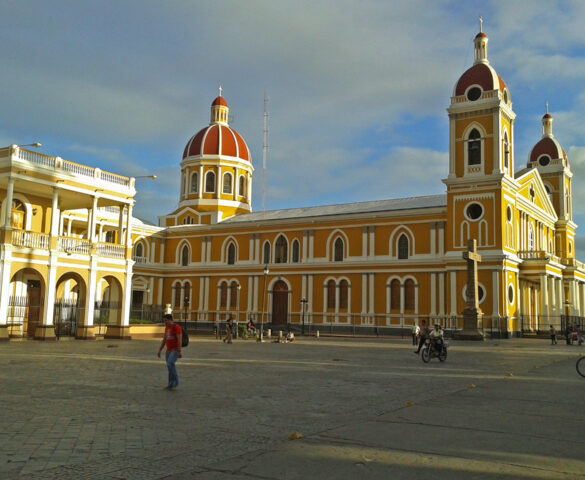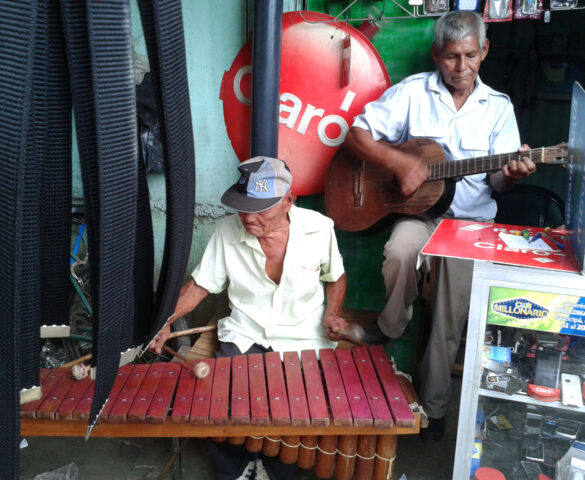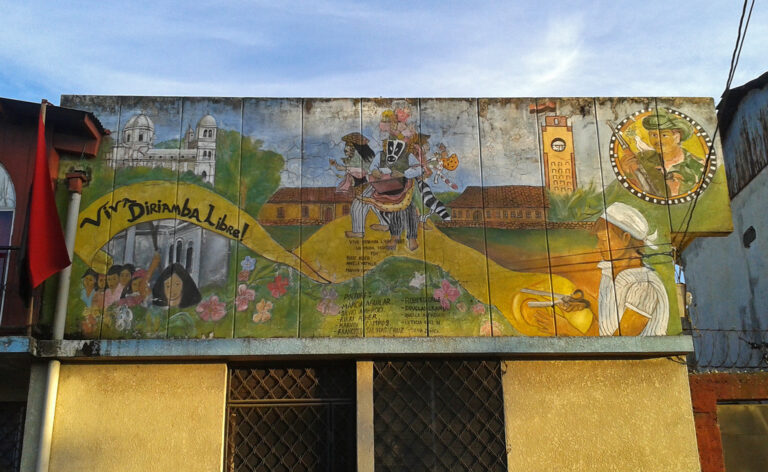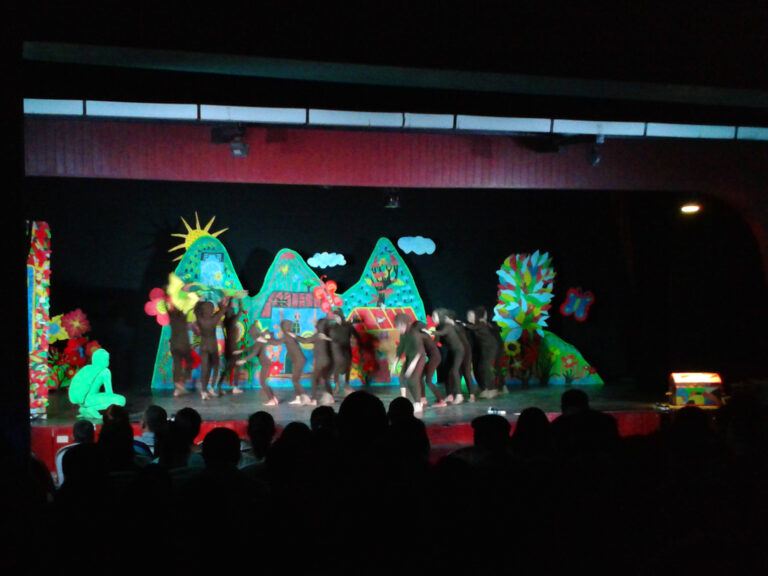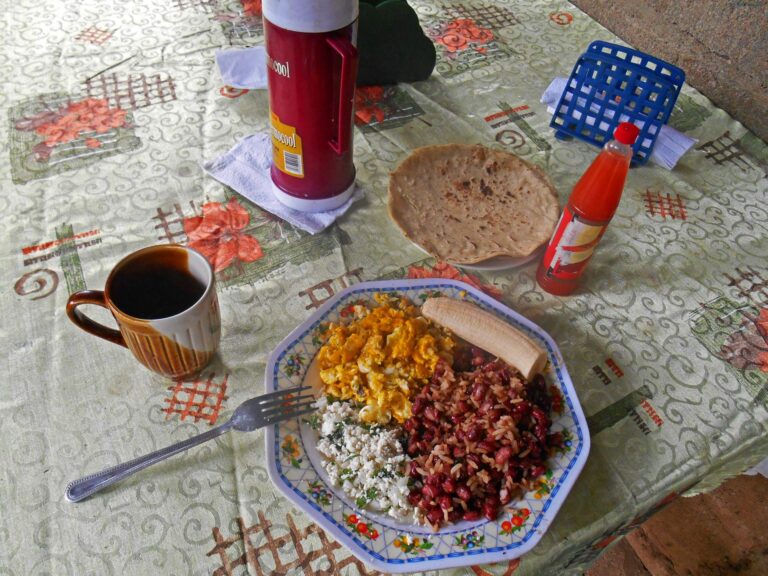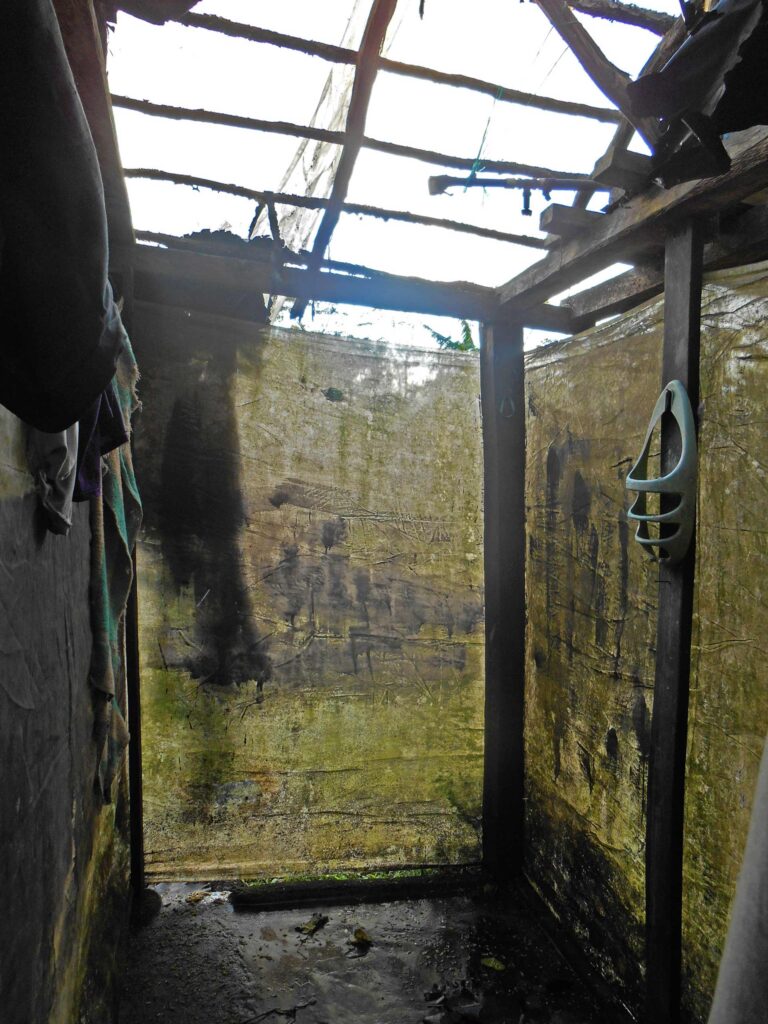
Fragments of worlds
My Fragment of Nicaragua
Nicaragua: from Sandino to the Toňa

Fragments of worlds
My Fragment of Nicaragua
Nicaragua: from Sandino to the Toňa

Fragments of worlds
My Fragment of Nicaragua
Nicaragua: from Sandino to the Toňa
Nicaragua
I have always associated Nicaragua with civil war .
Not anymore: after having been there, I associate it with the people I met and the experiences I lived.
At some point in my journey, I found myself off the tourist route and began looking abroad with different eyes. And I felt good thinking to document it for sharing. The first fragment of world was born!
A journey into modern Nicaragua, starting from its roots to get to the national drink, the Toña, along a path, traced by smoking volcanoes, through cities and remote rural villages.





Here you can leaf through my fragment of Nicaragua, that is my focus on this country; provides an insight into historical, geographical, cultural and many other points of views, following paths traced by my travel photos.
A subjective and not exhaustive overview, as result of my personal travel experience.
To increase knowledge of Nicaragua before traveling to this country or simply for spirit of knowledge.
Not a travel account, but a little trip to Nicaragua
Introduction
Since I was a child, I have always associated Nicaragua with civil war . Not anymore: after having been there, I associate it with the people I met and the experiences I lived.
Why Nicaragua? I wanted to visit a Central America country and, gathering informations, I discovered that Nicaragua is considered the most peaceful and safe country in the area, despite its history.
Moreover, it is still a genuine country, where tourism is increasingly developing, but has not yet reached the levels, for example, of neighbouring Costa Rica, a privileged destination for US tourism.
In Nicaragua you can speak English in hotel, but on the street you have to speak Spanish, and you will pay the lunch to the comedor with the Nicaraguan Cordobas.
This map outlines the topics of my “Fragment of Nicaragua”
 The topics of my “Fragment of Nicaragua”
The topics of my “Fragment of Nicaragua”
Not a travel story, but a small trip to Nicaragua, seen through my eyes of traveler from many points of view as result of my personal travel experience and my further study
Geography
Nicaragua is a small country, where about 6 million inhabitants live, located in the heart of Central America, between Honduras to the north and Costa Rica to the south. To the west it faces the Pacific Ocean, while to the east the Atlantic, in particular the Caribbean Sea.
Nicaragua political map
Since the country is small and most of the central area is difficult to visit, the travel routes, although very beautiful, extend over a small area, so it often happens to meet the same travelers in different places.
Below you can see the physical map.
The presence of the lake of Nicaragua stands out, the largest in Central America which, historically, has given the country a strategic importance: the presence of the lake in fact made it attractive to create an isthmus, like that of Panama, which would connect the two oceans.
Nicaragua is also a land of volcanoes that affect the entire strip of land overlooking the Pacific, as you can see from the map below
In this area therefore the landscape is dominated by the calderas of the volcanoes
 Nicaragua skyline dominated by volcanoes
Nicaragua skyline dominated by volcanoes
Some are always active, such as Volcan Masaya, considered “the most steaming“
Then there is a central area, north of Lake Nicaragua, close to the towns Esteli and Matagalpa, characterized by a plateau covered with cloudy forests.
Actually where crops are taking the place of forest.
Continuing east, the land slopes down to the plain of the coastal strip overlooking the Caribbean Sea. A lot of drug dealers are in this internal area who take advantage of the many coca crops.
The journey from the Pacific to the Atlantic is difficult and can be dangerous due to drug dealers. Therefore most tourists travel this route by plane. I have chosen to stay in the Pacific area.
The areas overlooking the Pacific and the Atlantic are strongly separated and represent two faces of the same country, with different cultures and languages, due to the different historical events that have seen the emergence of Spanish colonialism on the Pacific and the English one on the Atlantic.
History
Name Nicaragua derives from the Cacique (chief) Nicarao, chief of the homonym tribe who in 1522 arranged an agreement with the Spanish invaders, offering the conversion of the country to Christianity. This postponed for sometime the massacre of his people which took place a short time later at the hands of the Spanish.
Several indigenous groups lived at the time, including the Rama (on the Atlantic), the Chorotega and the Nicarao (on the Pacific).
The areas on the Pacific were colonized by the Spanish, those on the Atlantic by the British. This led to a linguistic and cultural difference that is still continuing today.
Independence from Spain came in 1821 and in 1860 the British Atlantic protectorate also became part of Nicaragua.
Coming to more recent history, in the 1900s Nicaragua was marked by bloody conflicts and by the US interference that sent the marines in 1912, imposing governments favorable to the US. After the retreat of marines, US supported the dictatorship of the Somoza dynasty which lasted for forty years.
 Samoza Garcia, the founder of the dictatorship of the Somozas
Samoza Garcia, the founder of the dictatorship of the Somozas
The US interest in this small country was in order to create a transoceanic canal similar to that of Panama right there, exploiting the lake of Nicaragua.
The pro-US conservative governments were opposed by rebels including Augusto Cesar Sandino who became the guerrilla leader and who came to control large areas of the country.
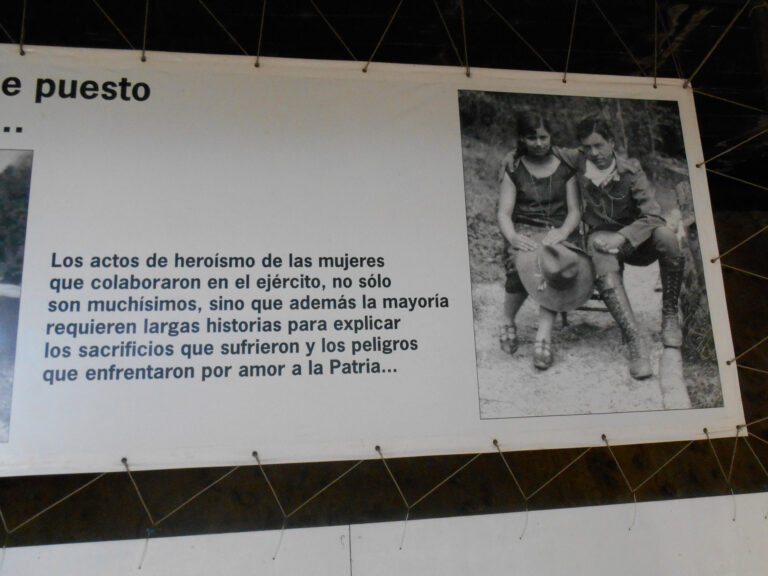 Sandino with his wife Blanca Arauz – Loma de Tiscapa Managua
Sandino with his wife Blanca Arauz – Loma de Tiscapa Managua
The warrior Sandino fighting for freedom is the most important reference figure for modern Nicaragua.
I chose to remember him by showing a photo that portraits him as a normal man, next to his wife Blanca Arauz
The photo is exhibited in the Parque Historico Nacional on the Loma de Tiscapa which is the most important (volcanic) hill in Managua.
Sandino and his men were assassinated in 1934, in an ambush carried out by Anastasio Somoza Garcia, at the time leader of the Guardia Nacional, who soon came to power becaming the founder of the dictatorship of the Somozas which was extremely corrupt.
Two different factions opposed the Somozas: The leftist movement Sandinista National Liberation Front (FSLN) and the moderate liberal wing.
In 1978, the assassination of the leader of the moderate Chomorro, triggered the revolution that led to the ousting of the Somozas and the creation of a government between Sandinistas and moderates;
But soon power was concentrated in the Sandinistas who carried out a policy of approaching the USSR and Cuba, provoking the reaction of the USA, which imposed sanctions and financed the armed opposition movement of the Contras which fought a bloody civil war against the Sandinistas.
Under the Reagan administration US financed the Contras, giving them the proceeds of an illegal arms sale to Iran during the Iran-Iraq war (1980-1988).
These events came to light and the scandal went down in history with the name Iran Contra or Iran gate.
The civil war lasted until 1990 when Sandinistas held free elections won by the moderates who kept power for the next 16 years.
Nicaragua today
Who is in charge today in Nicaragua is this man, Daniel Ortega, leader of the Sandinista party and hero of the revolution. He has has returned to power after 16 years of moderate government.
At the time of my travel, this propaganda manifesto was shown everywhere;
In a corner of the manifesto there is a yellow tree that reminds a little the tree of life by Gustav Klimt: it represents Ortega’s power and around Managua you can see many of it steel made.
Everywhere in Nicaragua the red and black symbols of the Sandinista party are painted; often to color the figure of a campesino with a hat. But often you can only find two stripes red and black painted side by side
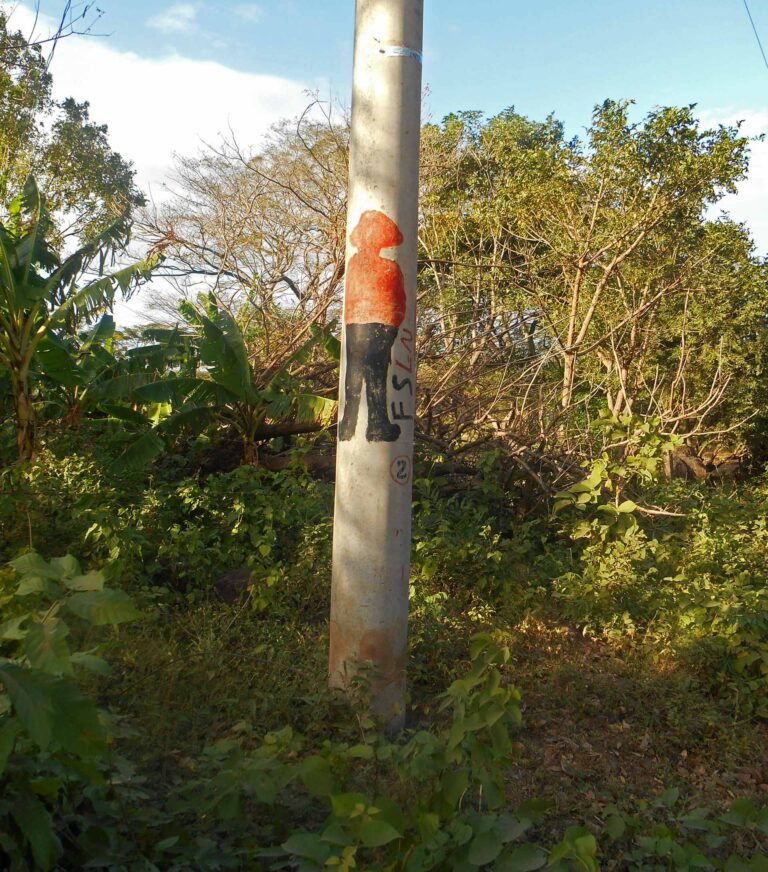 The FSLN emblem is drawn everywhere
The FSLN emblem is drawn everywhere
Two things struck me: the media talk about Ortega calling him by name, Daniel!
And in the small town of Diriamba I saw the Ortega’s manifesto reproduced on the the town hall facade, and in front the flag of the FSLN was waving next to that of Nicaragua!
 Diriamba Town Hall with Sandinista insignia
Diriamba Town Hall with Sandinista insignia
Ortega, actually, can be defined as the master of Nicaragua. He has led the country over pro-Russian and pro-Chinese positions.
For example, Nicaragua was the second country to recognize the separatist and Russian-protected regions of Abkhazia and South Ossetia in the Caucasus
On my travel I met at least three symbolic figures on which the cultural identity of modern Nicaragua is based .
Firstly Sandino, authentic national hero, whose statue dominates (next to the Ortega tree) the Loma de Tiscapa hill in Managua
 The imposing statue of Sandino (next to the Ortega tree)
The imposing statue of Sandino (next to the Ortega tree)
The Managua International Airport is dedicated to Sandino
 The Managua airport dedicated to Sandino
The Managua airport dedicated to Sandino
The second important figure for modern Nicaragua is Ruben Dario, the most famous Nicarguense poet.
 Two giants of Nicaragua: Sandino and the poet Ruben Dario
Two giants of Nicaragua: Sandino and the poet Ruben Dario
In Nicaragua, poetry is a serious matter; in the clubs evenings are organized in which anyone can attend reciting an own poem. One of the most important international poetry festivals is celebrated once a year in Granada.
Finally, the third figure is Macho Raton who is a character from the opera Il Gueguense (or Macho Raton) dating back 1500. It is a satirical drama and is the first literary work that blends elements of Spanish and native culture together. It is the story of an indigenous businessman struggling with the inept and corrupt Spanish; he will win out in the end with a little cunning.
The Macho Raton is represented with the body of a man and the head of a horse and this comes from the native culture.
Its representation can be found almost everywhere, even in the murals like this one
Murals are very popular in Nicaragua; they range from those made by children to play
 Children playing at drawing murals
Children playing at drawing murals
to real works of art.
 One of the many beautiful Murals
One of the many beautiful Murals
Mural has a long tradition and was used to communicate messages to a mostly illiterate population; the Sandinistas made great use of it to spread their revolutionary messages.
On my travel I also saw several murals like this one that approache the topic of violence against women and encourage women who have been subjected to violence to report.
 Mural encouraging women to report violence
Mural encouraging women to report violence
Nicaragua recognizes itself almost totally in the Catholic religion.
Churches are widely distributed: from the beautiful cathedrals, to the nice neighborhood churches, until the absolutely spartan ones of the villages, with tin roofs.
I read that recently Ortega government has tried to reduce the Church power by hindering the entry of the religious organizations into the country.
Changing the subject, the national sport is baseball, by far more widespread than football.
In the towns billiard rooms are very widespread
 One of the many billiard rooms
One of the many billiard rooms
And, unfortunately, slot machines arise wherever
And for your relax moments, a very comfortable hammock never misses, being really widespread throughout the country.
In Diriamba, lastly, I saw a theater essay by children; I was surprised to see them dancing on the Swan Lake notes, not exactly Nicaraguan
However, in the colorful scenography I found the contribution of local culture to the ballet representation
From cities to villages
In Nicaragua there are notbig cities, but towns that you can easily visit on foot. The capital, Managua, does not offer much from a tourist point of view, but it is certainly authentic and there are very few tourists.
The most visited city is no doubt the pretty colonial city Granada with its beautiful buildings and the beautiful cathedral
 Colonial style buildings in Granada
Colonial style buildings in Granada
As in many other towns, the main church face a garden (the Parque Central) where in the evening many stalls (fritangas) offer delicious street food.
However in Granada, with its main street full of restaurant tables crowded with tourists, I didn’t feel to be n Nicaragua! The Comedors were gone, as well as the Gallo Pinto, at least in the center.
As always, however, it is enough to move a little away from the central street to come across something authentic as the covered market with its full of fish stalls.
However, the most picturesque market I found, is the Masaya one
In the Lake Nicaragua waters, just close Granada, Las Isletas rise, volcanic islets archipelago, once populated only by the poorest inhabitants; today wealthy families are increasingly purchasing the isletas, replacing the poorest ones.
 Sumptuous mansion on one of the Isletas
Sumptuous mansion on one of the Isletas
Then there are the smaller towns, those completely outside the tourist route and, therefore, more authentic. I visited Diriamba and I liked it very much with its low and colorful houses.
In general, despite Nicaragua is a poor country, I have not seen degradation and the towns are absolutely respectable.
On the coast there are small fishing villages, as Las Penitas, where early in the morning adults and children wait small fishing boats arriving on the beach, to unload and clean immediately the freshly caught fish.
 Cleaning of freshly caught fish in Las Penitas
Cleaning of freshly caught fish in Las Penitas
Finally, there are the tiny villages, for example the ones I have seen on the Ometepe island and in the rural areas of the northern plateau.
In these places the paved roads soon give way to unpaved ones and and trails.
In every village the main commercial landmark is the pulperia, where you can find everything you need.
Cuisine
Nicaragua’s national dish is Gallo Pinto, which is rice and beans cooked separately and then fried together.
Gallo Pinto is served at all meals, from breakfast to dinner. What is different is the side dish: usually eggs and cheese for breakfast
For lunch and dinner, on the other hand, meat stew: the choice is everytime between res, cerdo or pollo, that is, cow, pork or chicken.
Nicaraguans have their meals in the Comedor, little spartan restaurants of the hit and run type that serve Gallo Pinto at will, with a choice of res cerdo or chicken.
Maduro (plantain) is also widely used as gallo pinto side dish; it can be added uncooked, or sliced and fried. The plantain is similar to a banana, but larger in size.
On the coast, fish is consumed at will. However, both in restaurants and in the fritangas (street food), it is usually cooked fried with a lot of oil, so it becomes dry and heavy to digest
 Fritanga with fried fish in Las Penitas
Fritanga with fried fish in Las Penitas
The kitchens of street food stalls can really be very artisan!
 Fritanga with wood fire in Las Penitas
Fritanga with wood fire in Las Penitas
If you like eating lighter, at restaurant you can ask fish cooked a la plancha, that is grilled, with an extra price, but with a much better result.
 Plancha fish served with Gallo Pinto in a more elaborate version
Plancha fish served with Gallo Pinto in a more elaborate version
Coffee is served everywhere, but although Nicaragua is a coffee producing country, “Presto” instant coffee is served everywhere.
Only in Granada you can enjoy the city specialty: the Vigoron: a salad made with cabbage leaves and jucca.
Finally, the national drink spread throughout the country: The Toña beer, a real hit!
Travel to Nicaragua
In Nicaragua people travel mainly with the dense network of colorful buses
Bulky luggage is loaded on the roof; buses travel sold out, with people crowded into the corridor,
while those behind share the space with bean bags and bunches of plantain
 Bunch of plantain traveling on a bus
Bunch of plantain traveling on a bus
Buses can be so crowded that I once could’t get off at the right stop.
To get the most remote locations, they venture on dirt roads, raising clouds of dust.
Especially in urban routes you can take the collective taxi, that is a taxi shared with other people along the way. Here too don’t think of traveling too comfortable
In Granada, however, you can travel more comfortably by carriage
Finally, there are ferries sailing on Nicaragua lake. Here I traveled more comfortable, but on the journey to Ometepe Island, a sailor activated continuously a manual pump to draw water from the ship hold and discharge it into the lake. This didn’t give me the feeling of such a safe journey!
 By ferry on the lake: the water is drawn from the hold and discharged onto the deck
By ferry on the lake: the water is drawn from the hold and discharged onto the deck
Highlights
On my travel I had many experiences that will remain in my memory, but on all, two of them particularly struck me and I want to focus:
spending a few days in the rural hinterland of the Miraflor Protected Area Reserve on the northern plateau, to understand something about the lifestyle of his inhabitants, and visiting the Ometepe Island to admire its incredible nature
The rural hinterland of the Miraflor Protected Area
I wanted to visit the hinterland of rural Nicaragua, where local tourism is developing, made up of farmer families who host tourists in their farms.
I was a guest of one of these families, inside the Miraflor Protected Area, in the Esteli area, where I discovered another world from mine or at least, I would say, a very isolated world: to get to my destination from the town of Esteli, it took me two hours by bus, including one on a dirt road. And then little less than an hour walking along a little dirt road through the countryside covered by a thick fog.
Their house is a simple made in concrete blocks house, with the kitchen under an canopy; it is completely surrounded by green, and located in a tiny village, connected to other villages by rough roads
 The house where I was a guest in the Miraflor Protected Area
The house where I was a guest in the Miraflor Protected Area
outside the wood oven
The bathroom is outside, a hole inside a shack
for the shower, also outside, there is a water tank heated by the sun
No electricity; there is a solar panel for light, but to small for powering the fridge; the water is from source, because there is no aqueduct and obviously no gas.
Water for tourists is filtered; but I didn’t trust and I drank only coffee for three days!
In such a place everything seems to be missing, but at a closer look it is not really like that.
The household is an extended family: father and mother live with their three daughters, two of which are married and with a child each.
The family is as more as possible self-sufficient: they produce coffee, fruit, vegetables, milk, cheese, eggs and some meat. Other food is bought, for example rice.
Someone in the village owns a van and makes it available; so they can transport their product foods to be sold in the town; then in the pulperia they buy what they need. And with a little tourism they can still get some money.
To give an idea of the size of this tourism, the house where I stayed had 6 beds for tourists. When I arrived I was the only one, the next day a Canadian girl arrived.
I wanted to spend a whole day with them, giving up exploring the surroundings to try to understand something of their lifestyle.
So at 7 am departure for the countryside: the team was made up of the father with the two sons in law, the two kids in tow and a horse.
The day’s work was creating a branch from a water conduct to bring water to a tank for watering the cows.
So they dug a trench with a pickaxe, laid the new conduct made of plastic pipes joined together, up to the tank and finally connected it to the “mother” conduct; all, I would say, with great skill.
And while the adults were working, the kids… .played a few meters away
 While the adults are working, kids in tow play
While the adults are working, kids in tow play
Therefore there’s no need for kindergarten and the kids are looked after also during the working day.
Just after noon the work was done and the tank was full of water
 Completed work: the tank full of water
Completed work: the tank full of water
and so we set off happily on the way back to get home at 1 pm, where the lunch cooked by the women was waiting for us.
 Returning cherfully for lunch time
Returning cherfully for lunch time
And in the afternoon…. relax for everyone! I collected some coffee in the backyard!
On the way to the house they made me clear that they feel self-sufficient and ecological: they don’t need to spend money on diesel fuel for the tractor, because they use horses or oxen; they do not have to pay bills for water, gas or electricity and in addition they do not pollute.
In short, they told me proudly that they lack nothing, while we have to buy all we need and in addition we pollute. Despite what it may seem at first glance, they feel don’t have nothing to envy to tourists.
In the extended family they help each other, everyone has his own tasks, and when the family can’t provide, the inhabitants of the village help each other.
But not everyone likes this life: one of the two boys explained to me that he and his wife were there only for the weekend.
In fact, the two boys, with their wives, made deeply different choices..
Tino, wearing a coverall, chose with his wife countryside life model where he was born. He lives and works with his wife and daughter in the house of his parents in-laws.
Juan and his wife, on the other hand, did not choose this kind of life and went to live in the town, where they both found a job.
But by leaving the household they had to pay a very high price: no one in the town can take care of their kid during working hours. And so the kid remained to live in the countryside with her grandparents while her parents can join her only on weekends.
The Ometepe island
One of the most fascinating places from a naturalistic point of view among those I have visited, is certainly the Ometepe Island.
The eight-shaped island is dominated by two volcanoes: the Concepcion, active, and the Maderas, extinct
 The Ometepe island, dominated by the two volcanoes
The Ometepe island, dominated by the two volcanoes
The strip of flat land surrounding the two volcanoes is really thin.
An unmistakable sign indicates the escape route in case of eruption, but considering the geography of the island, it didn’t give me great safety!
 The evacuation route… ..will it be useful ??
The evacuation route… ..will it be useful ??
In all landscapes I admired, the Concepcion volcano dominates with its tipical shape of… volcano, and with a white cloud constantly lying on the top
On the southern side of the Concepcion is located the Charco verde reserve, where I took beautiful promenades on the lakeside, walking on the beach, nothing more than a thin strip of sand between the forest and the lake
 A strip of sand invaded by the forest that flows into the lake
A strip of sand invaded by the forest that flows into the lake
admiring white and blue birds with and a sort of some antennae on the head. I’m not an ornithologist, but from what I’ve read, it should be the blue jay.
These uncontaminated places moved me for their beauty. Absolutely no one around, so I could safely bathe naked. Only a little anxiety because of the strong wind and by hearing in the distance some animal sound, almost a roar.
In Ometepe everyone greets you; you can see women washing clothes in the lake waters
 Clothes are washed in the lake
Clothes are washed in the lake
and in the small villages many houses have no entrance door or is anyway kept open, so walking I could see families relaxing in front of the TV.
Close to the Santo Domigno beach much mentioned on guidebooks (beautiful, but moving along the coast there are others just as beautiful and more authentic because there is no tourism), I had a coffee. The waiter brought me the sugar bowl and removing the cover I found some midges swimming in the sugar. So I told the waiter that all in all I preferred sugar-free, but he told me … don’t worry
I’ll take care of it! He disappeared for a moment and then came back with a sugar bowl equal to the other one ( the same ???), but without midges. At that point how to refuse? So I put a small amount of sugar in the coffee. I was able to drink it half, not because of midges thought, but because it was really undrinkable!
However, small setbacks like this soon give way to the beauty of this island and the richness of its fauna.
I have seen a lot of it canoeing (with a guide) on the Istiam river. The trip is beautiful because the river is narrow and flow through a dense vegetation rich in birds, turtles and…caimans.
In particular, I made “friendship” with a large caiman who stood immobile in the sun on a rock. We approached it till 2-3 meters with the kayak: I could see his teeth coming out of the closed mouth. I was a little upset (no … I was really scared); instead the guide was excited and literally snatched the camera from my hands to take pictures himself, because he said he had never seen a caiman so big.
All of a sudden the caiman opened his mouth wide, because he was hungry according to the guide. I don’t know if it was just like that or if the guide caught my upset and wanted to have a little fun.
He then explained to me that caimans feed on small animals as fish, birds, amphibians, small mammals. No human prey then…
Shortly after we met another one, this time smaller, it too immobile but immersed in water. He had a sympathetic look.
The route of my trip to Nicaragua (Jan 2014)
|
1 |
sun |
Milano – Managua |
|
2 |
mon |
Managua |
|
3 |
tue |
Managua – Leon |
|
4 |
wed |
Leon – Vulcano Cerro Negro |
|
5 |
thu |
Leon – Las Penitas |
|
6 |
fri |
Las Penitas resera Isla Juan Venado |
|
7 |
sat |
Las Penitas – Esteli |
|
8 |
sun |
Esteli – Area Protegida Miraflor |
|
9 |
mon |
Area Protegida Miraflor |
|
10 |
tue |
Area Protegida Miraflor- Matagalpa |
|
11 |
wed |
Matagalpa – Ometepe |
|
12 |
thu |
Ometepe – (reserva Charco Verde) |
|
13 |
fri |
Ometepe – (Santa Cruz) |
|
14 |
sat |
Ometepe -Rio Istiam |
|
15 |
sun |
Ometepe – San Juan del Sur |
|
16 |
mon |
San Juan del Sur – Playa de Coco |
|
17 |
tue |
San Juan del Sur – Granada |
|
18 |
wed |
Granada – Laguna de Apoyo |
|
19 |
thu |
Granada – Isletas – Diriamba |
| 20 |
fri |
Diriamba – Huehuete beach |
| 21 |
sat |
Diriamba – Mirador Catarina – Masaya |
| 22 |
sun |
Masaya – Vulcano Masaya |
| 23 |
mon |
Masaya – Managua – Milano |



